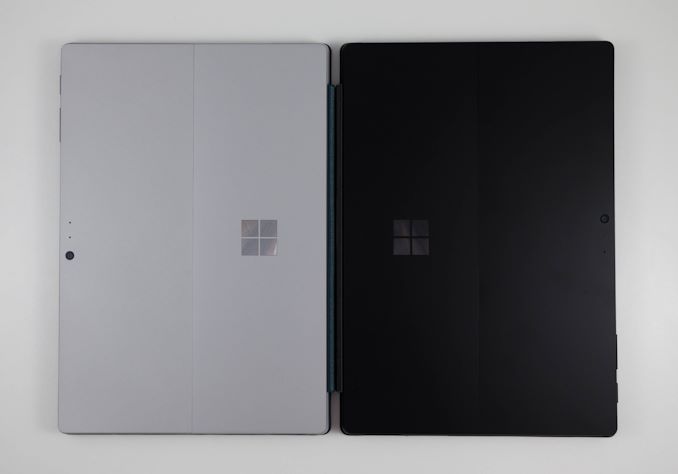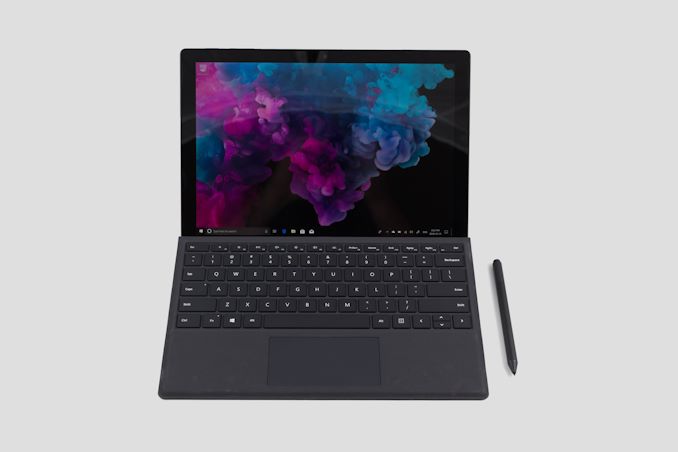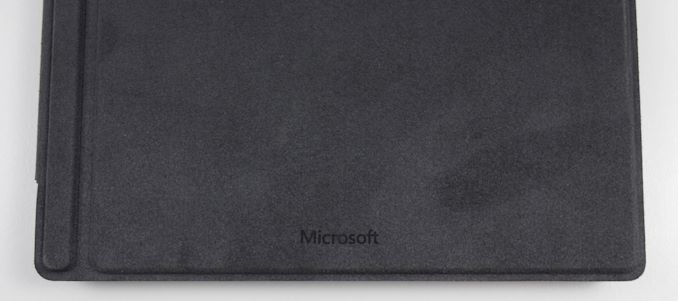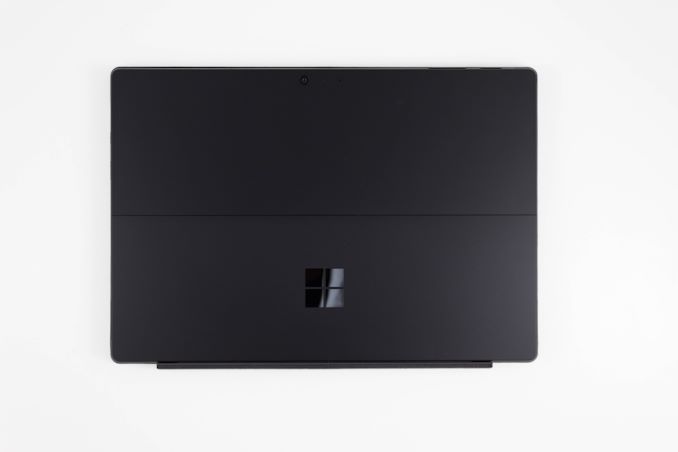The Microsoft Surface Pro 6 Review: More Than A Color
by Brett Howse on October 16, 2018 3:01 AM EST- Posted in
- Laptops
- Microsoft
- Surface
- Tablets
- Surface Pro
- Surface Pro 6
Final Words
At the launch event in NYC on October 2nd, the Surface Pro 6 seemed like a mild refresh of an already established line, and that’s not even necessarily a bad thing. The exterior is more or less identical to the outgoing 2017 model, albeit with a new color option to sit beside the platinum that we’ve seen on all Surface devices for the last couple of years. The pen was immensely improved just last year, and carries over. The alcantara type covers were introduced last year, and once again carry over to this model. There’s still not a USB-C port on Surface Pro, and for no really good reason.
 Surface Pro 2017 (left) in Platinum vs Surface Pro 6 (right) in Black
Surface Pro 2017 (left) in Platinum vs Surface Pro 6 (right) in Black
But after using the device for the last couple of days, there’s more than meets the eye. The big change with Surface Pro 6 is the move to Kaby Lake Refresh, and the doubling of the CPU cores that entails, and unsurprisingly the performance of this model is much better than all previous versions. The lack of an Intel Iris GPU option was unavoidable, since it no longer exists in the 15-Watt range, but even so, the Iris in last year’s Surface Pro was restricted by the low TDP anyway, and as such didn’t always offer the expected performance boost.
Microsoft has also taken the opportunity to improve the already class-leading display in the Surface Pro 6. It’s just as accurate as ever, but now offers a noticeable bump in contrast ratio. If you want an accurate display in the PC space, only Microsoft calibrates every device they sell, and the 12.3-inch display on the Pro lineup offers everything you’d expect in a premium PC, with high resolution, accurate colors, and full sRGB coverage. It would be nice to see Microsoft use Surface as a line to drive HDR adoption, but apparently, we’re not quite there yet. The 3:2 aspect ratio is still the right choice for a device like this, and that’s apparent when you see the competition all adopting the same aspect ratio on their lineups.
The other nice addition this year is even better battery life, with a significant jump across all of our tests. The Surface team achieved that without increasing the rated battery capacity, which if a guess had to be made, would come down to an improved display TFT since the display is still the biggest power draw by a wide margin.
Finally, there’s the new old black color, which we hadn’t seen on Surface since the Surface Pro 2. It looks good, but it does get dirty much quicker than the platinum that they used before, with fingerprints and hand oils showing up very quickly. The other nice benefit of the platinum color is that any scratches to the finish should be mostly masked by the color of the underlying metal, but it’s too early to tell how durable the new black finish will be, so this may or may not be an issue. Likely it will be though, unless you are someone who never scratches a portable device.
This was also our first chance to test out the passively cooled Surface Pro, since we were only able to test the Core i7 model last year, which did feature a fan. The Core i5-8250U in the Surface Pro 6 was able to maintain an average of over 15 Watts of power dissipation indefinitely, although the power would drop periodically to maintain surface temperatures. The added benefit of a completely silent device can’t be overstated either, and unless you really need maximum performance, the fanless model is probably the way to go.
Nothing big has changed for this year, but this version still seems like a nice improvement regardless. If anything, it’s the release cadence of Surface that is the most baffling. It seems like Microsoft is concerned with having another launch go as poorly as it did with Surface Pro 4 and Surface Book, where the Skylake power management issues caused them a lot of grief. When the company moved to Kaby Lake in summer 2017, it fixed those issues, but Kaby Lake was launched in the second half of 2016, meaning Microsoft was selling the Skylake models for far longer than they needed to. Microsoft seems to want to refresh when they want to, but it’s not always to their benefit, and rarely good for their customers, for them to sit on products well after the rest of the competition has moved to the latest products inside. The Surface Pro 6 is launching with Kaby Lake refresh right as Whiskey Lake is launching, which isn’t going to be a dramatic improvement in performance, but it does include hardware mitigations to Spectre and Meltdown which will now not be available in the Surface Pro for the foreseeable future. We are seeing the 2018 Surface Pro 6 launching with the same wireless adapter as the Surface Pro 3 had in 2014, and even in 2014 it wasn’t the best Wi-Fi adapter. The USB-C is another example of where they’ve decided to dig in their heels for almost no reason, since having a second USB port would probably be welcomed by more users than those that want to use mini DisplayPort, even though that’s available over USB-C anyway.
Microsoft’s Surface lineup has always been about a premium device, and to showcase their software, and the Surface Pro 6 delivers on that front. Despite the somewhat questionable update cadence, and even the lack of USB-C, the changes that are here are all very welcome. No one is going to complain about more color options, and the improvements to performance and especially battery life are a boon to all Surface Pro users. These changes bring it to a level that Surface Pro has never been to before. Microsoft is being safe with the Surface Pro, but it was already the class leader, so it’s hard to fault them on that. The Surface Pro 6 is a much bigger update than just a new color.













80 Comments
View All Comments
sorten - Tuesday, October 16, 2018 - link
And to think that the only reason I have a SP4 instead of a SP3 is that I was holding out for a USB-C port! It would have been fairly early to market at that point. Looks like I made a great decision.damianrobertjones - Tuesday, October 16, 2018 - link
Tell me... what would you use that port for? You can do it... you can hold out for the Surface pro 3.You could always try the 'Surface Connect to USB-C Adapter'?
Heck wouldn't it be great to run USB c raid arrays with this? No.
Heck wouldn't it be great to have an external GPU with this? No, how much money do you have!?
Heck wouldn't it be great to have a fast usb C thumb drive? No, USB 3.1 drives are still selling lots.
Heck wouldn't it be great to have HDR?
Oh, here we go, the next excuse.
drew805 - Tuesday, October 16, 2018 - link
The main draw of the Type C is that I can charge my laptop and phone with the same charger (and even power my 2in1 with a mobile power pack with USB-PD). I fail to see how a more future proof port that already offers display out capacities is worse than the mini-DP in the SP5. Also, while External GPU's via Thunderbolt 3 are expensive, it is cheaper than building a complete desktop just to get a similar (or likely better) experience. Why is more choice bad?damianrobertjones - Wednesday, October 17, 2018 - link
It's not bad, at all, but the quality on the USB C chargers is startling. Same with the docks. Plus it's another change to overcharge for something that should realistically be cheap. While all of the printers, scanners, mice, keyboards and thumb drives are still USB, USB C can just wait.Plus there's always the MS adapter. People are probably not aware of that.
desolation0 - Wednesday, October 17, 2018 - link
Usb-c and usb-a ports aren't exactly mutually exclusive. We can pretty easily have both simple backwards compatibility and future proofing in the same model. Meanwhile the future proofing option offers obvious and significant utility opportunities that are just not available on the previous generation spec. To skip it on a flagship device when the tech has been available for years and is now being used by pretty much all of the competition even down to mainstream pricing levels seems like a significant oversight.digiguy - Tuesday, October 16, 2018 - link
Brett, I think you are underestimating the difference between the 2017 i5 and i7 in battery life. I have seen reports of over one hour more battery like in the fanless i5. So I don't think battery like in the 2018 model has improved much or at all. Once we have some direct i5 to i5 comparisons (eg. from notebookcheck) we'll be able to see if there is any improvement worth mentioning.OCedHrt - Tuesday, October 16, 2018 - link
The black levels on surface 6 and 4 are the same?Brett Howse - Wednesday, October 17, 2018 - link
Yes and the display is 100 nits brighter so being able to reproduce the same black level with a white that's 100 nits brighter is a sizeable improvement.evilspoons - Tuesday, October 16, 2018 - link
Argggh, I hate that Avastar wireless card so much. I have a Surface Pro 3 and it posts decent 802.11ac speeds for when the SP3 was new... most of the time... but sometimes it just decides to screw up and slow down by like 90%. Copying files over the network, wired gigabit to wired gigabit PC? 60 MB/sec, forever. 802.11ac adapter in my dad's laptop? 40 MB/s. That damn Avastar? 30 MB/s, until it decides to screw up, then 2.5! Yay!Holliday75 - Wednesday, October 17, 2018 - link
Yeah my SP3 is slower than shit on my WiFi. Usually get around 22-25MB/s. I had to force it to 5.2ghz to get those speeds.